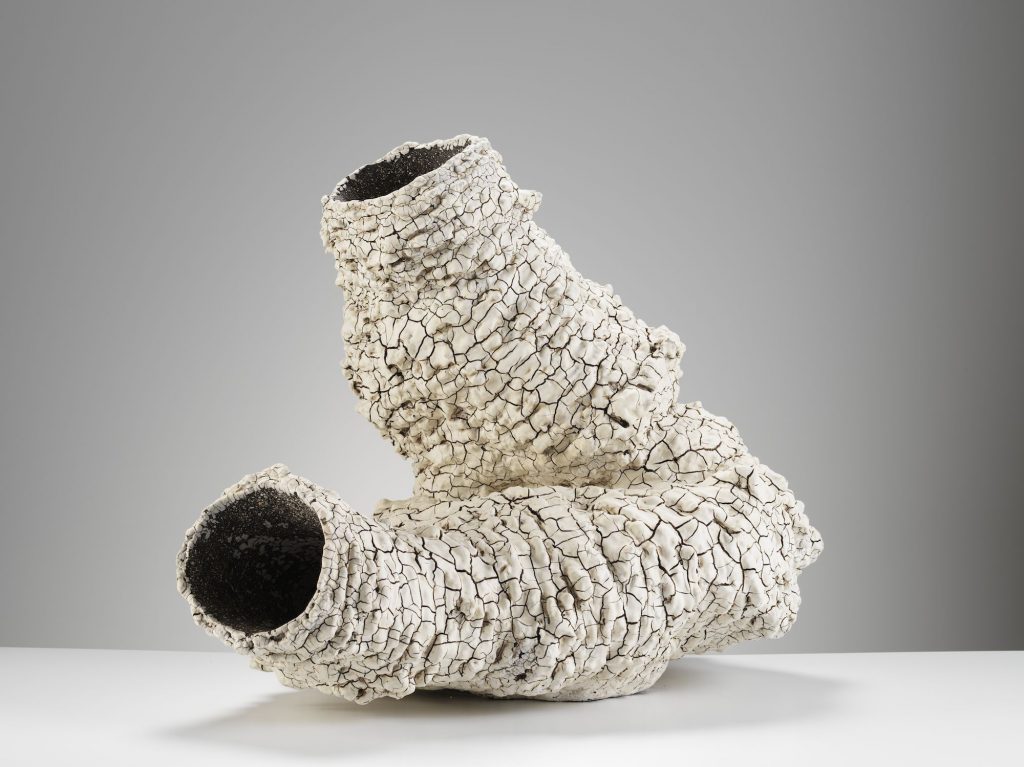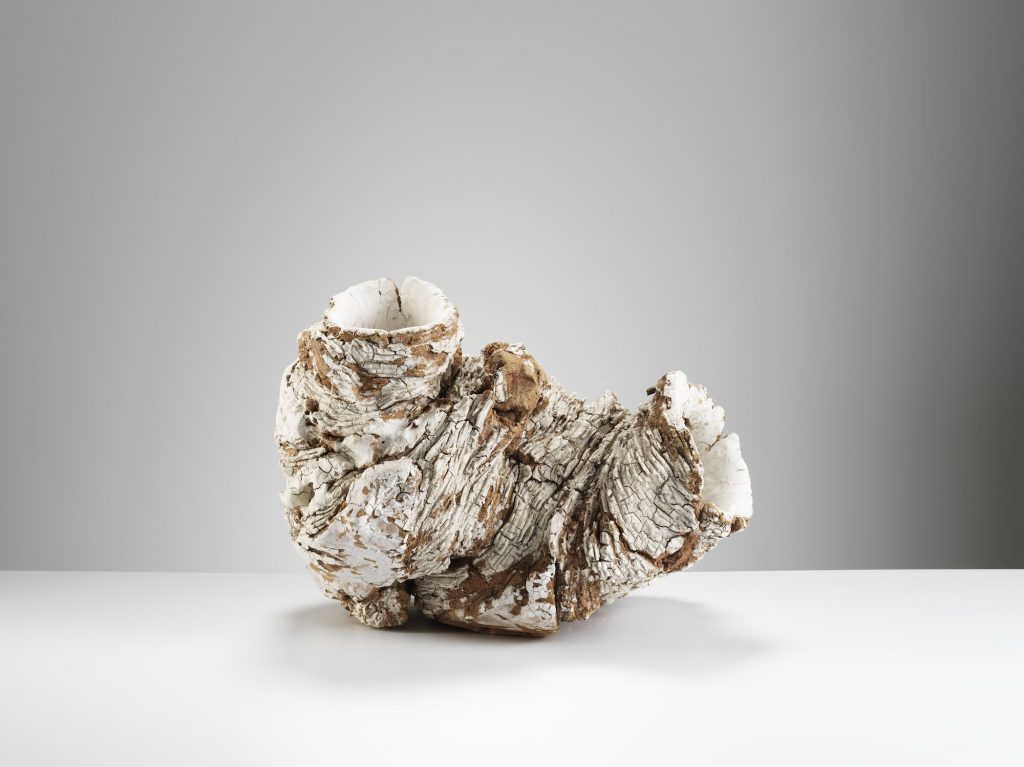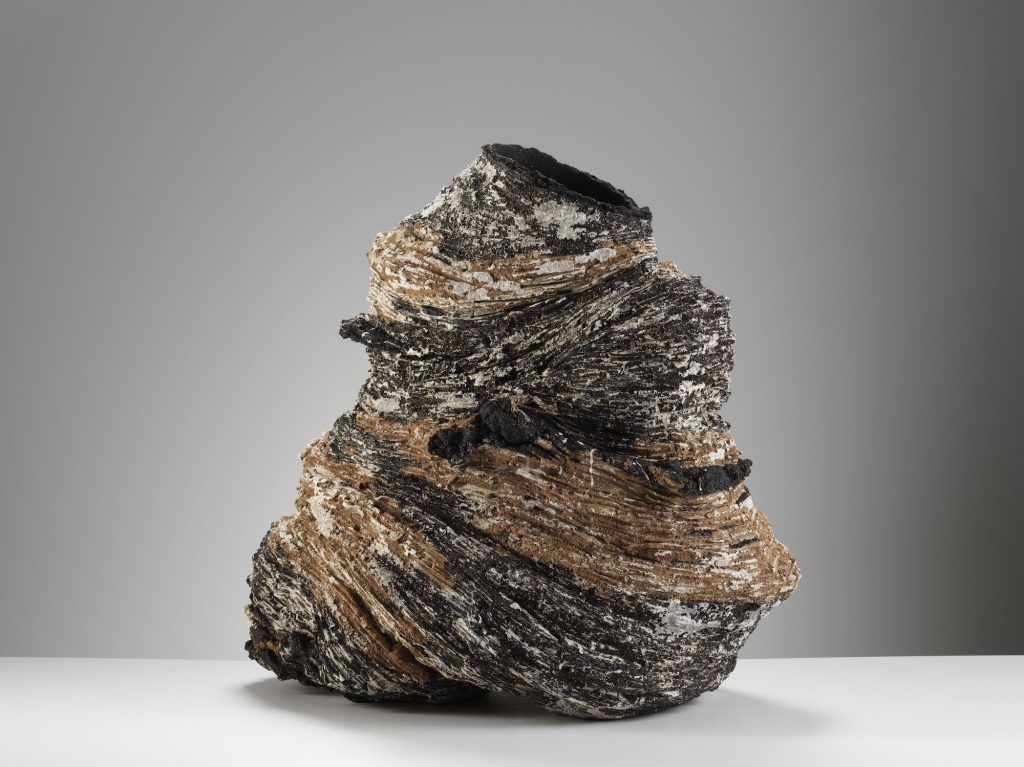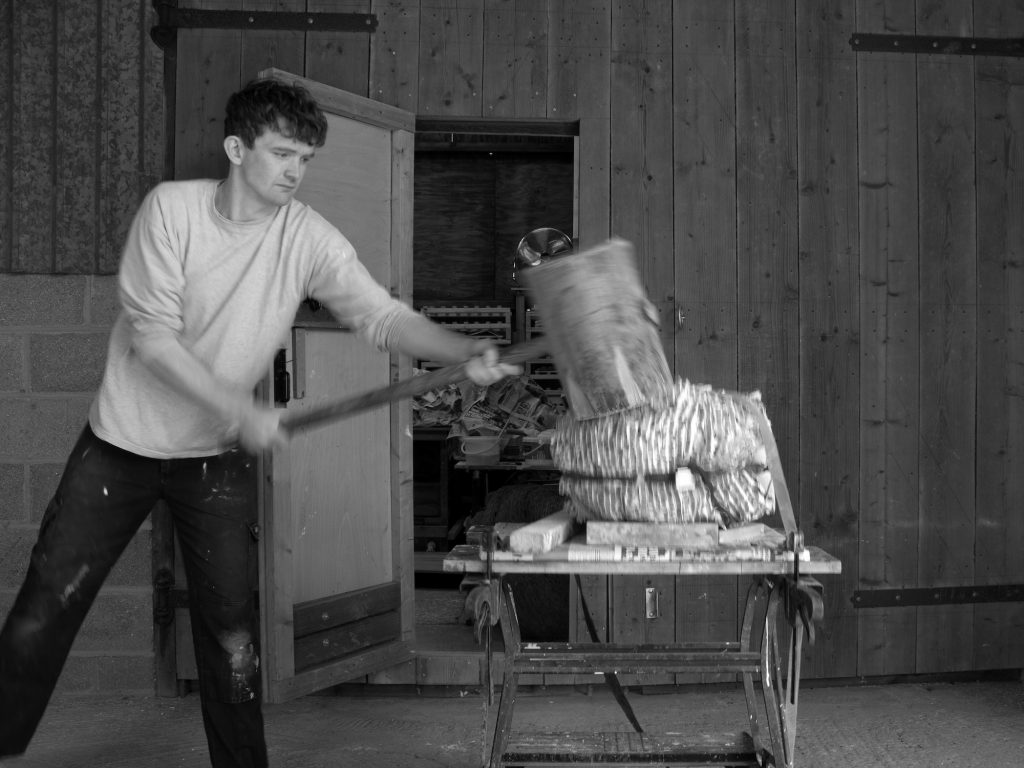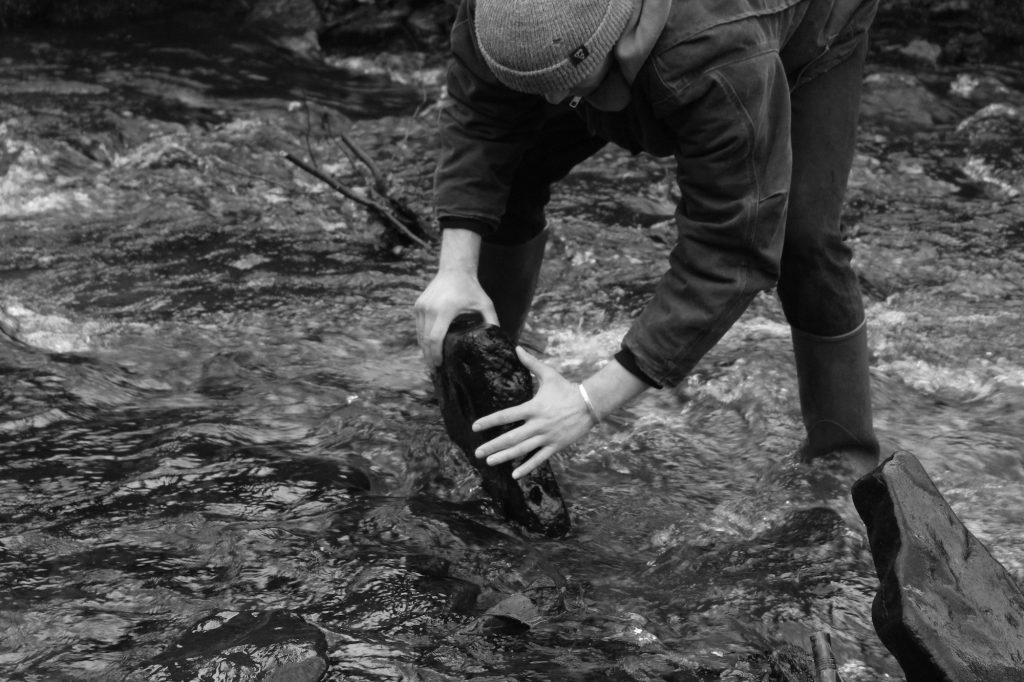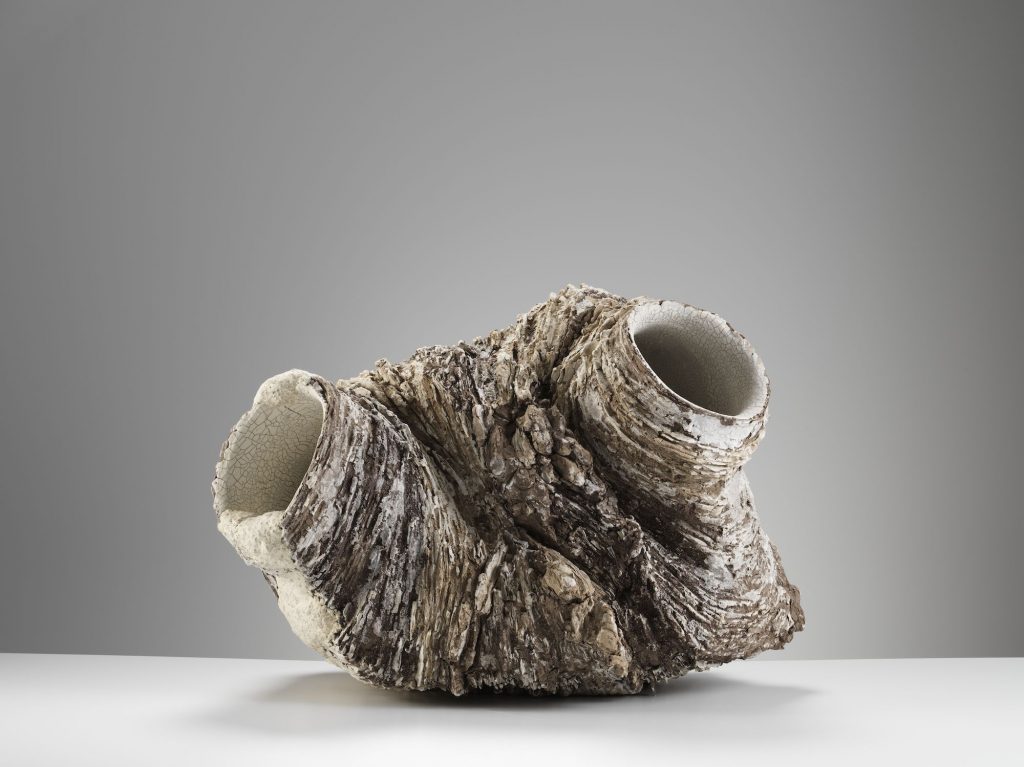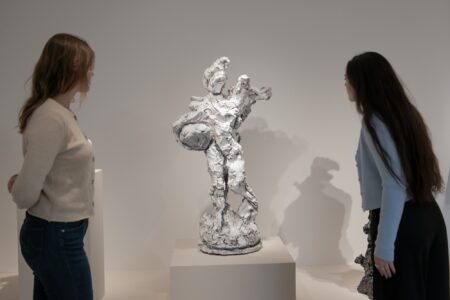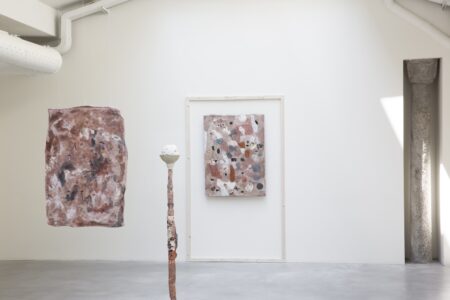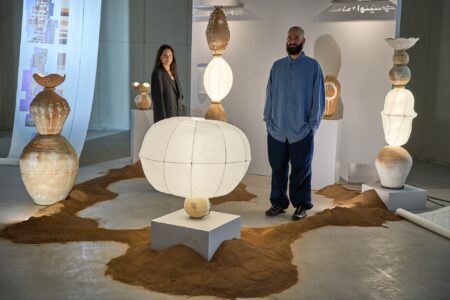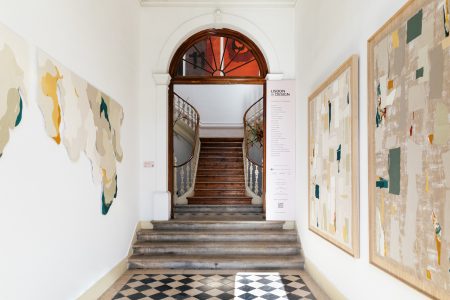Luke Fuller – All Chaos is Put into the Dark Inside of the Art
Like relics from a former coal mine or volcanic explosion, Luke Fuller’s layered and abstract ceramic sculptures are physical reminders of what lies within the earth and the precarious relationship that humans have with the environment. A selection of his work will be on view at Sarah Myerscough Gallery through January 29th, 2022.
There are moments in the making of his new sculptures when Luke Fuller wields a hammer to alter a form. The violence of the intervention is in stark contrast to other procedures, such as the patient construction of cardboard moulds and impressing of the clay. The actions may be emblematic of emotions in this pandemic era: sudden outbursts alongside incremental acts of care. There is an echo of other eras when ceramic art has offered radical statements of renewal in the aftermath of human catastrophe, such as the Abstract Expressionist Californian scene in 1950s America and the Sodeisha movement in Japan, begun in 1948. Fuller admires their legacy, the gestural methods of abstraction resonating in his works, but his subject has contemporary urgency, which he terms “the ambiguous relationship between humans and the natural environment”.
Fuller’s interventions in shaping form parallel humans’ interventions in nature: the process is of one of constant alteration and evolution, partly controlled and partly beyond control. His forebears were steelworkers and coalminers in South Wales, his father escaped to office life and Fuller decided on art school as a way of using his hands to different ends: “I hope that in the making of the work I have embedded signifiers (conscious or unconscious) which express landscape, industry, geology and human experience”. An epiphany for Fuller was a visit down a mine to witness the underground reality of miles of fissured coal in a hollowed-out space, natural land made unnatural by human intervention. Nature became a source of an imaginative fiction of infinite possibility that interconnects the whole universe.
Fuller cites a favourite recent book, Robert Macfarlane’s Underland, which explores the literally hidden depths of our planet. A chapter explains how research scientists seek dark matter a thousand metres below ground in Yorkshire in order to understand the stars “to further our knowledge and to give life meaning. If we’re not exploring, we’re not doing anything. We’re just waiting.” Humans’ engagement with caves and mines stretches Fuller’s imagination also into realms of science fiction. Reality becomes a construct, with sculptural form as interlocutor of what any of us might understand about existence and knowledge. As Keith Oatley, novelist and psychologist, writes: “Realism, as what one might see out there in the world, can be compared with the thoughts, desires, and always-partial understandings of the interior mind: what goes on in the world compared with what we project onto it. We can think, perhaps, of art as balanced on this border between the exterior and the interior.” Macfarlane pinpoints the paradox of interiority: “Into the underland we have long placed that which we fear and wish to lose, and that which we love and wish to save”. Working towards this exhibition in isolation through the seasons of the pandemic, surrounded by giant corrugated metal silos on a Hertfordshire farm, Fuller avers: “I am finding my way through”.
The physical and conceptual burrowing from exterior to interior gives Fuller’s sculptures a bodily scale and abstracted figuration: his own arms and torso determine the extent of the form. Whether destined for wall or plinth the empathetic, passionate sculptures explore the bodily in relation to land, space and time – surfaces poised between skin and rock as a representation of living human/nature. Coarse, highly grogged clay bodies have iron chromate and manganese dioxide applied and colours underscore restless animation. We discern blackness, congealed blood reds, ecru, onyx, shades of brown, grey – and white.
White plays a special role in the sculptures: “I embrace how the pristine white surface cracks and falls apart, particularly as a lot of ceramicists are trying to avoid this from happening when using porcelain.” It is indeed the antithesis of the archetypal harmony of white ceramics, exemplified by the Korean moon jar of the Joseon dynasty (1392-1910), the white pots of Modernist Lucie Rie (1902-95) and potter Edmund de Waal’s examples in his book The White Road and exhibition White: a Project in 2015. Fuller avows a different allegiance, explaining that his use of white, “helps bring light into a space to highlight the inside spaces/voids. I want the inside of the work to be experienced. It’s a great way to help unify a form and surface, perhaps in a similar way to Cy Twombly”. The subversive tendency is shared, whether in relation to ceramics for Fuller or the traditions of ancient Greek and Roman sculpture for Twombly (1928-2011). Twombly said ‘White paint is my marble’ and yet, as noted in the 2019 Gagosian exhibition, Twombly is ‘subverting marble’s classical connotation of perfection through his roughly painted surfaces’.
Colour articulates material. This essay’s title is from the writings of American artist Robert Smithson (1938-73), whose Spiral Jetty (1970) on the Great Salt Lake in Utah is literally a mark in the land – a revolutionising landmark – of modern art. In this extract, Smithson underlines the relation of material to metaphor, which is at the core of Fuller’s practice:
“Solids are particles built up around flux, they are objective illusions supporting grit, a collection of surfaces ready to be cracked. All chaos is put into the dark inside of the art. By refusing ‘technological miracles’ the artist begins to know the corroded moments, the carboniferous states of thought, the shrinkage of mental mud, in the geologic chaos – in the strata of aesthetic consciousness.”
The ‘strata of aesthetic consciousness’ could be describing the entropic layerings of Fuller’s sculptures. He is practising a kind of archaeology, a digging into the earth to materialise human experience. In his exploration of industrial archaeology, Fuller takes account of the implications of the military-industrial past. He enthuses about theorist Paul Virilio’s book Bunker Archaeology (1975), which is also an important reference for current archaeologists who excavate what they term the ‘contemporary past’. They reason that the era of living memory is the most important for being within our personal and familial experience of everyday life. Archaeologist Alfredo Gonzalez-Ruibal writes: “The mission of a critical archaeology of this period is not only telling alternative stories but also unveiling what the supermodern power machine does not want to be shown. For this we need to develop a new kind of archaeological rhetoric, pay closer attention to the materiality of the world in which we live.”
Fuller can be viewed as developing a new kind of ceramic rhetoric, one that removes the enduring associations with romanticism, the picturesque and heritage. As humans continue to wreak havoc on the environment, Fuller pursues a critical path: “I think the work does at least acknowledge the confusing state of the world and thoughts we are all having surrounding these subjects. The infrastructure we have created relies on industrialisation but I feel like we’ve got to a point where we’re not prepared to hear about it or acknowledge it.” The Indian writer Amitav Ghosh was asked recently what individuals can do now and his answer reflects Fuller’s intent: to produce “artworks to think about the current crisis, how the past relates…contemporary artists, writers, intellectuals, scientists, activists working together to produce new art – we must imagine a new civilisation by these means”.
Terra – Form, an exhibition by Luke Fuller, is on view at Sarah Myerscough through January 29, 2022.
This article originally appeared in the A/W 2021 issue of TLmag36: All Is Landscape.
sarahmyerscough.com
@sarahmyerscoughgallery
lukefuller.co.uk
@luke.fuller
